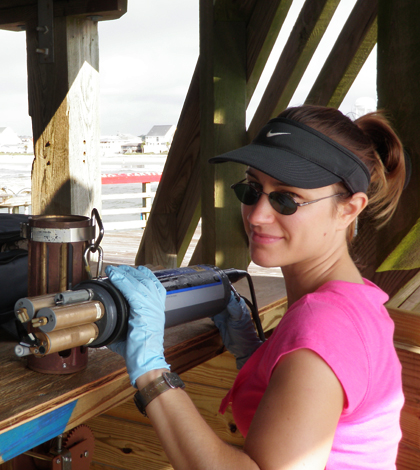Q&A with Danielle Doremus on monitoring hypoxia along the Grand Strand

Danielle Doremus at work with a multi-parameter water quality sonde (Credit: Scott Kindelberger)
The Grand Strand is a stretch of virtually uninterrupted beach that covers more than 60 miles of the South Carolina coast, including the iconic Myrtle Beach. A hypoxia event in the waters of Long Bay took managers by surprise, but a coalition of scientists have since responded to get to the bottom of the problem. Danielle Doremus, a research specialist with Coastal Carolina University’s Environmental Quality Lab, answered a few questions about a three-station water quality and meteorological monitoring network that is helping to uncover the causes and effects of low dissolved oxygen.
Environmental Monitor: What brought about the monitoring network along Long Bay?
Danielle Doremus: The Grand Strand’s economy relies predominantly on beach-based tourism, attracting approximately 15 million visitors per year, which substantiates the necessity of monitoring and maintaining the quality of coastal waters. In July 2004, hypoxic conditions (less than 2 mg/L of dissolved oxygen) were discovered in the nearshore waters of Long Bay by faculty and students of Coastal Carolina University. Local fishermen were also reporting flounder jubilees, a phenomenon where various types of bottom-dwelling organisms will leave deeper waters and swarm in large numbers to the surface seeking more oxygenated water. There were also reports of bait fish dying in buckets that were suspended mid water column.
The nearshore waters of Long Bay are also prone to exceedances of water quality standards for fecal indicator bacteria. The sources of the oxygen-demanding substances responsible for sustaining low dissolved oxygen in Long Bay are unknown, illustrating the importance of managing terrestrial flows and the importance of detection and prevention of polluted stormwater runoff and its potential contribution of oxygen demanding materials.

Myrtle Beach occupies a stretch of the Grand Strand. (Credit: Phil Guest, via Wikimedia Commons)
EM: Any clues to what might be causing the low oxygen?
DD: These conditions are thought to arise from a physical constraint on mixing caused by typical weather conditions of the season. Thus resulting in nearshore waters being kept close to the coastline, confining nutrients and organic matter where they stimulate aerobic respiration resulting in oxygen depletion.
EM: What steps have been taken to monitor the coast since hypoxia was discovered?
DD: Several state agencies partnered to establish continuous water quality monitoring platforms at two piers, which were up and running by the summer of 2006. The monitoring stations were equipped with multi-parameter data sondes deployed inside standpipes that were anchored to pilings, just beyond the surf zone.
Due to lack of funding, monitoring ended at one of the piers in 2007. In August 2011, the Long Bay Hypoxia Monitoring Consortium (LBHMC) was established by a resolution of the Coastal Alliance, which is of the mayors from many of the coastal municipalities of the Grand Strand. Efforts of the LBHMC have expanded and further enhanced monitoring at two additional fishing piers.

A winch system lowers monitoring equipment into the water, eliminating issues with standpipe sensor housings.
EM: What’s unique about your new deployments?
DD: The two new platforms deploy multi-parameter sondes in the surface and bottom waters from stainless steel zip lines. The zip lines are attached to a robust anchor system built to withstand the high-energy conditions characteristic of the nearshore environment. This novel approach minimizes sampling artifacts associated with standpipes. The surface sondes are mounted to floating sleds that run along the steel cables.
An approximate depth of 1 meter below the surface is maintained by an innovative counterweight system. The sleds are constructed of half-inch copper pipe to help control biofouling. The bottom sondes are stationed approximately 1 meter above the seafloor in water depths ranging from 5 to 7 meters with respect to the tidal cycle.
EM: How is the 2014 season shaping up as of mid-July?
DD: Our hypoxia season hasn’t really kicked in yet. It is generally August to September. Oxygen levels have dipped down a little bit, but nothing too noteworthy yet. One of our platforms sustained damage from a recent lightning strike. We’re trying to troubleshoot what is damaged and what is not.
Top image: Danielle Doremus at work with a multi-parameter water quality sonde (Credit: Scott Kindelberger)




0 comments